HOW TO READ A GIA DIAMOND REPORT
UNDERSTANDING GIA DIAMOND REPORTS AND CERTIFICATES
This post contains affiliate links. If you use these links to buy something I may earn a commission. Thanks! As an Amazon Associate I also earn from qualifying purchases.
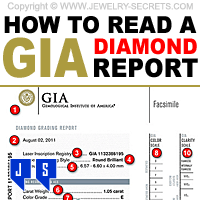
Diamond reports, or as most people refer to them as, diamond certificates, can hold a wealth of information. But they also tend to become confusing for many customers. They look at these reports and don’t even know where to begin.
What does it all mean? What should you look for? How do you read a diamond certificate report?
Let’s find out…
I’m going to stick with the most popular diamond certificate out there: GIA (The Gemological Institute of America).
GIA is king!
GIA is the top of the line and set the standards that all other certificate companies, jewelers, and gemologists use to grade, price and sell diamonds with (GIA actually created the 4 C’s).
AGS (The American Gem Society) is also a great certificate to get, but since most people are more aware of GIA, I’m going to focus on that.
GIA Diamond certificate:
First off, let’s look at a real diamond report, as obtained from James Allen at the time of this post.
The official diamond is listed as a 1.05 VS1 E Brilliant Cut Diamond.
This is an EXCELLENT diamond to purchase for it excels in just about every aspect of diamond grading.
It’s top notch and very few diamonds could do better.
Here’s a microscopic image of the actual diamond, so you can see it’s full beauty and stunning qualities.
There are 20 points that I want to cover in this post. I have marked them on this certificate below to help you understand where everything is.
Print it out and follow along with me…
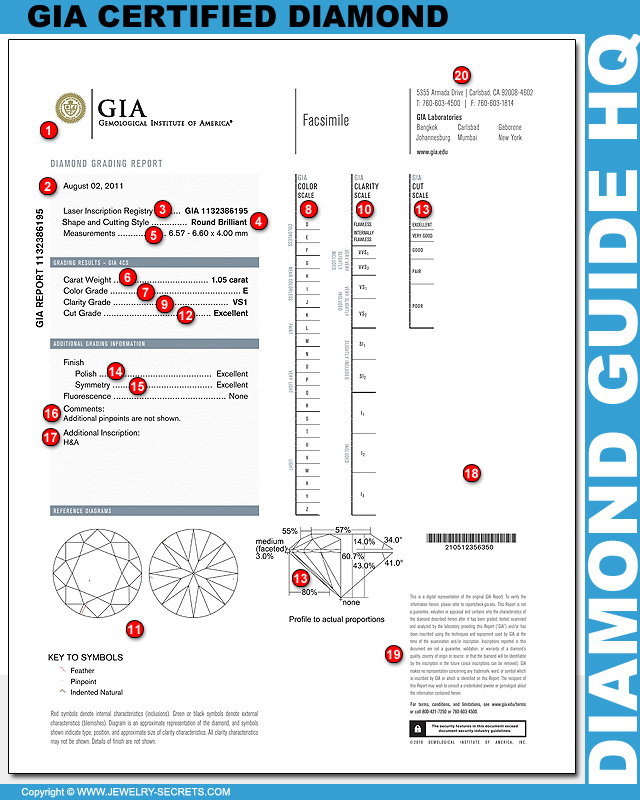
1) GIA logo:
Don’t get confused with acronyms. The certificate you want is GIA. There are plenty of other certificate companies out there that may look similar as far as the logo or initials go, but the reports are not the same, and the grading will not be the same.
Some companies are lax and way off. Be careful you get the right one.
You’ll see acronyms like: EGL, IGI, HRD, plus numerous local independent gem and diamond certification companies (like Tiffany) with any number of acronym possibilities. They may even sound similar…
But don’t be fooled. Stick with GIA (or AGS).
GIA is the most accurate certificate you can get. They are very strict in their grading and are highly respected in the field.
If you buy GIA, you won’t regret it.
2) Check the date:
The date is an eye-opener and can tell you a number of different things.
If the date is current (this year), then you know that the diamond is freshly graded, brand new and as up-to-date as possible.
A certificate with an old date should set off a warning flag.
If the date is years old, ask yourself “What is it about this diamond that keeps people from buying it?“
If a diamond sits that long in inventory, it could mean that the quality is low, the cut is poor, or the price is too high.
An older date (especially if it’s over 5 years) could also mean that the diamond was previously owned and returned, sold or traded in.
This is fine and dandy if the diamond comes back in mint condition. But many times a worn diamond shows signs of wear and tear. Things like chips or nicks around the outer edge of the diamond: the girdle!
Any damage done to the diamond after it was certified will not show on the report.
So an old date should tell you to inspect the diamond well (under a 10x microscope) and look at the facets and girdle for any signs of damage, chips, nicks or cracks that could have resulted over the years.
Many diamonds will likely be new, so this shouldn’t be an issue, but keep this in mind if you do run across an old stone.
If you do find a damaged diamond, it will affect both the clarity of the diamond (lower the clarity, and sometimes all the way to the bottom depending on how bad the damage is) and of course the price. That diamond should be either re-cut or re-polished again, or at the very least, re-appraised again so the report is up-to-date.
Now we get into the main key points of the certificate. These topics can get rather large and very detailed. I’ll keep this as short and to the point as possible.
The main key points are:
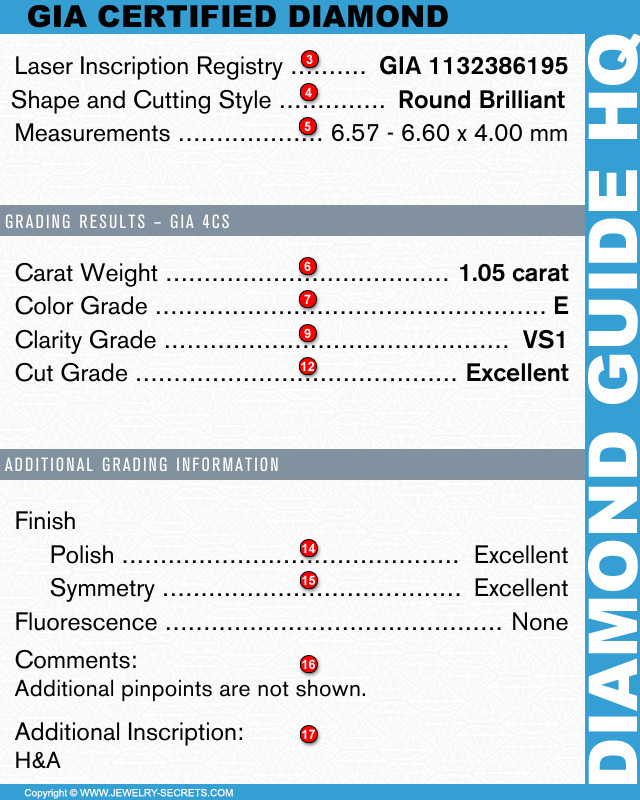
3) GIA laser inscription:
Not all certified diamonds are laser inscribed (but I wish they were). I love inscriptions. :)
If your diamond is laser inscribed, that means that the diamond report numbers (or what ever is inscribed), will be laser etched directly onto the side of the girdle as shown in the image below…
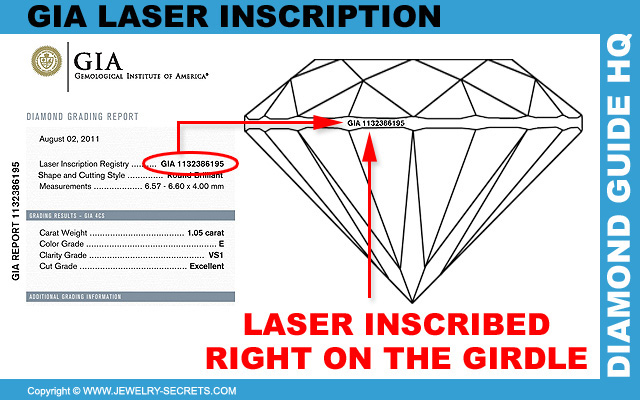
The laser inscription for this diamond report is “GIA 1132386195“. And yes, that entire thing will be lasered onto the edge of the stone.
You can view this inscription (you must view your inscription – THEY ARE AWESOME!) under a 10x (ten times magnification) microscope or 10x jewelers loupe.
Viewing the inscription allows you to match it up to the numbers on the actual report. This proves that the diamond you’re looking at, is the diamond listed on the report.
Just be careful when you’re holding the diamond with tweezers, if care is not taken, you could damage or chip your stone.
Without an actual inscription, you may never know if the diamond is in fact the one on the certificate.
Without that exact means of identification, you’ll have to rely on other things to identify your stone. Things like: comparing the diamond’s measurements, looking at the culet and girdle dimensions, comparing color, viewing your inclusions and comparing them to the diamond plot…
It gets tougher to identify, but any good jeweler, appraiser, gemologist, or diamontologist can help you quickly determine if the diamond in question is the same one listed on the laminated document.
4) Diamond shape and cutting style:
Notice that the shape and cutting style is not listed under the 4C’s section of the report.
Even though many people refer to cut as the shape of the stone, these 2 things are quite different.
The shape is basically the outline or shape of the stone: round, square, rectangle, triangle, pear, oval, heart…
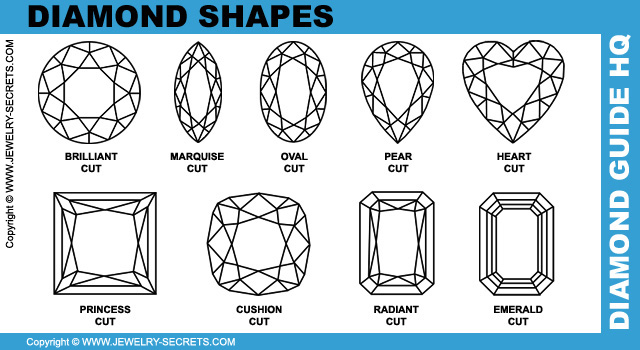
While the cutting style is the actual styling of facets placed on the diamond. Like: brilliant cut, single cut, ideal cut, modified brilliant cut, step cut…
It’s important to note that the most popular cutting style is the brilliant cut.
This modern cut helps maximize light that enters and exits the stone. It makes a diamond sparkle (if done well).
It’s also important to note that almost all other cuts of diamond on the market, princess cut, radiant cut, pear cut, heart cut, marquise cut, oval cut, are modified versions of the brilliant cut. Hence, they get the name of modified brilliant cuts on the diamond report:
i.e. a princess cut is usually listed on a report as a square modified brilliant cut.
5) Diamond measurements:
Measurements can tell you a lot about how a diamond is proportioned and sized. You can quickly see if a one carat diamond is close to ideal measurements just by comparing the mm sizes.
An ideal 1.00 carat round brilliant cut diamond measures 6.5mm. This diamond in this example, measures “6.57 x 6.60 x 4.00mm“. This tells me that the diamond is almost perfectly round (just off by .03mm), and that the diamond is just a tad bit (not noticeable) larger than a perfectly cut diamond.
Granted, this diamond should be almost perfect, because it is an excellent cut stone, and an excellent cut, along with an excellent clarity and color, should be cut well. It would be a shame to take such a nice quality stone and destroy it with a bad cut.
Usually when you’re looking at high quality stones, the cut usually follows in suit as well (or close to it).
Standard round diamond mm sizes are as follows (and their particular carat weights):
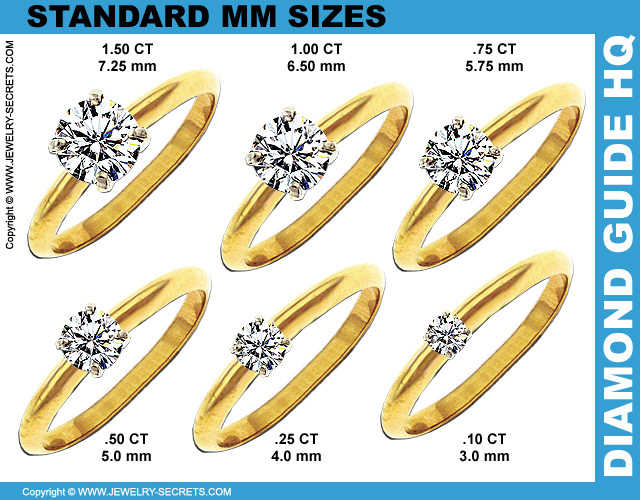
Now we get into the meat and potatoes of the certificate, the 4 C’s.
The 4 C’s:
Under the heading of “grading results – GIA 4 C’s” you’ll see…
6) Carat weight:
The carat weight of the diamond is how big or how many carats the diamond is.
A one carat diamond is 1.00 carat, or 100 points.
So there are 100 points in a full carat diamond.
- 25 Points = .25 Carat (Quarter Carat)
- 50 Points = .50 Carat (Half Carat)
- 75 Points = .75 Carat (Three Quarter Carat or 3/4 Carat)
- 100 Points = 1.00 Carat (One Carat)

With carat weights, it all breaks down just like money. 100 Pennies = One Dollar. 100 Points = One Carat.
So if a diamond is .95 carat, that means it’s just 5 points shy of a full carat stone.
Buying a diamond like this, that’s just a couple of points shy of one carat (or any main carat weight) will actually save you some money.
Any carat weight over 1.00 is rare and the price tends to jump.
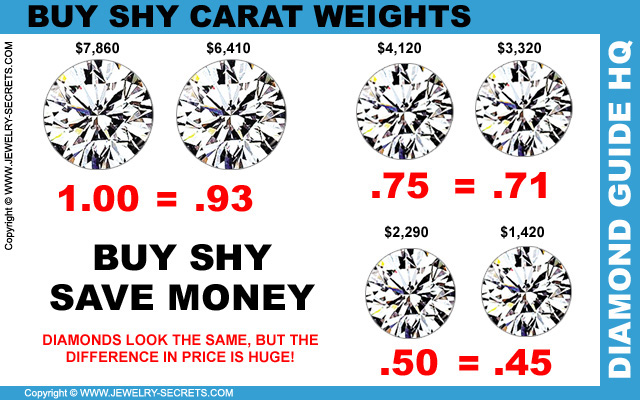
An easy way to tell if your diamond matches the one on the actual report, is to have the jeweler weight the stone in front of you. The carat weights should match (as long as their scale is calibrated correctly).
If it’s off by more than a point or two, it may be wise to have the clarity and color double checked as well. These are good indicators that the diamond is not all that it seems.
7) Diamond color grade:
The color grade refers to the actual body color of the diamond. As most of you know, most diamonds found on the market today are in the colorless or near colorless range. D-E-F diamonds are colorless and make up the top 3 color grades. They are considered pure white (note that there is no A B or C in diamond color).

Colorless diamonds are very bright and very white. Almost like a spot light is put on the diamonds. I love colorless diamonds. My favorite color is E color. I highly recommend them.
G-H color is the next best thing to colorless diamonds. G and H makes up the top half of the near colorless range and are still considered a fine white diamond (or off-white).
Most people won’t see any color whatsoever in these ranges. That’s why it’s good to buy at least H color or higher.
When you go lower down the color charts (I, J, K, L, M…) you get into stones that will exhibit some body tone colors, like faint yellow, light brown, and even shades of gray.
When you have a diamond that looks yellow to the bare eye, it usually makes that diamond look dingy, dirty, old or antique (think yellowed from age).
Most people prefer white diamonds, but you can get some great deals on diamonds with color.
And if you set a yellow diamond into a yellow gold mounting, you almost won’t be able to tell the diamond has any color in the first place.
Plus, if the diamond is cut well, and is clean (good clarity), the brightness of the stone will cover up some, or all, of the yellow color as well. :)
My advice: compare colors for yourself. See if you can visually see the difference between an E, G, or J diamond. If not, don’t worry about it.
If color doesn’t bother you (some people love a warmer looking stone), then great, save the money and buy a near colorless stone or a faint yellow diamond.
But if you want the cream of the crop, purchase a pure white diamond and let the beauty begin.
8) Diamond color grade chart:
This is the actual color grade chart as devised by GIA. It begins at D (the best), and continues all the way through the alphabet to Z.
There are 5 color grades in all: colorless, near colorless, faint yellow, very light yellow, and light yellow.
Beyond Z, is what they call Z+, or fancy diamond colors.
For example, the Hope Diamond is a fancy colored blue diamond. The Cape Canary is a vivid strong yellow diamond that’s also one of the most famous diamonds in the world.
Color is great if it’s strong… But a faint cast usually doesn’t look so hot.
9) Diamond clarity grade:
There are 11 clarity grades in all: 2 in the flawless range: flawless and internally flawless. 2 in the VVS range: VVS1 and VVS2. 2 in the VS range: VS1 and VS2. 2 in the SI range: SI1 and SI2. And lastly, 3 in the I clarity range: I1, I2 and I3.
See the GIA diamond clarity grading chart below…
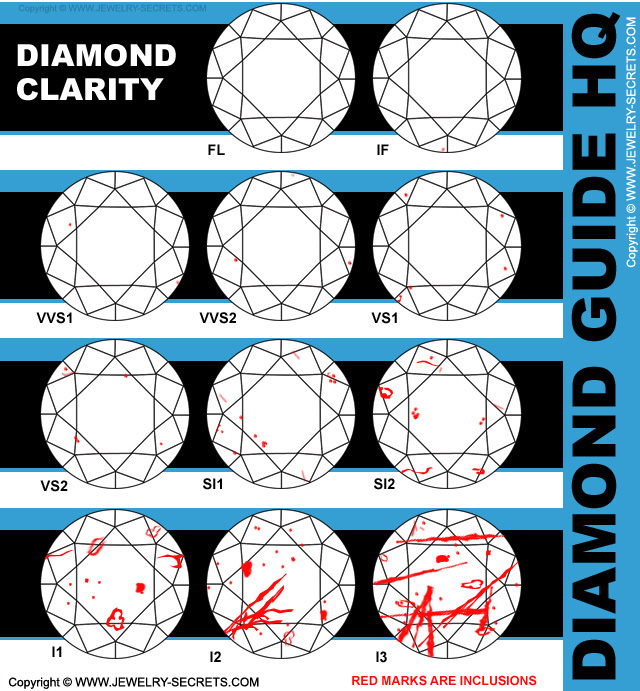
Most of what you’ll find on the general market is VS, SI or I clarity diamonds. That’s because of rarity and price. The higher up the scale you go, the more that diamond will demand price.
The biggest thing to learn about clarity is the difference between invisible inclusions and eye-visible inclusions. The difference can be startling.
Any diamond that has eye-visible traits, like big black spots in the stone that you can see with the bare eye (not using a loupe or microscope), is considered either an SI2 clarity diamond or lower. Usually if you can see big flaws easily just by glancing at the stone, it’s an I1, I2 or I3 diamond. These are the lowest clarity grades possible, and they are low for that reason.
You can quickly see the flaws.
When you get into SI1 clarity or higher (what I always recommend), the tables turn. You won’t see the inclusions with your bare eye. You’ll need a 10x jeweler’s loupe or microscope to spot them. And even then, sometimes this gets pretty difficult to an untrained eye (and even to a trained eye).
I usually recommend SI1 or higher. That way your inclusions or imperfections won’t take away from the beauty of the stone and they won’t stop light from bouncing across the diamond and coming back out in a splash of brilliance and fire.
My favorite clarity:
My favorite clarity is VS clarity. I love VS stones. But, if you put an SI1 clarity diamond up against a VS stone, you wouldn’t be able to tell the difference. Sure, under a scope you’ll see more flaws in the SI1 diamond, but nobody carries around a microscope. So the biggest difference you’ll see is price. :)
I love VS just because I’ve been dealing with diamonds all my life so I’m pretty bias to quality.
Because SI1 stones are eye-clean and face up so well, it makes them the most popular clarity in the world. They’re beautiful and you don’t spend an arm and a leg for them.
Buy SI1 or higher and you’ll get yourself a great looking stone.
10) GIA clarity scale:
The actual clarity scale is listed on the side of the diamond report. What this chart also shows you is the rarity each range is found in nature.
VVS1 is not equal to I1 in quantity. I1 is much more abundant (stones with visible flaws) on the market and actually makes up almost half of the diamonds you’ll find. Eye-visible flaws are everywhere.
The higher up the scale you go, the slimmer and more narrow your choice of stones become.
Almost everything in nature has it’s own finger print, or identifying marks. This makes grading diamonds judgmental, but it also helps in identifying your stone.
And one of the easiest ways to identify your diamond, is by looking at the diamond plot…
11) GIA diamond plot:
The plot is literally a diagram of your flaws mapped out exactly where they fall inside the stone.
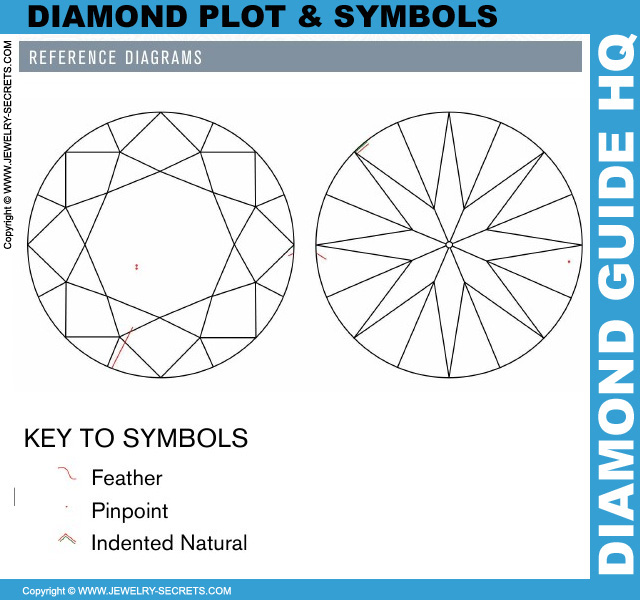
Here is a side by side comparison of a diamond with big, easy to see flaws, along with the actual diamond under a microscope and it’s plot.
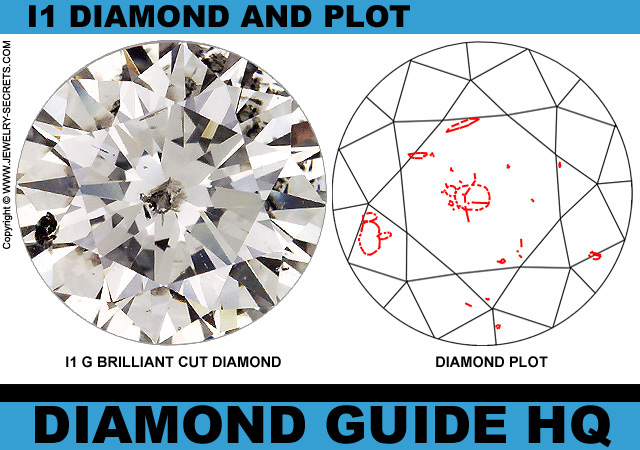
Notice that it looks like there are even more flaws and imperfections in the stone that aren’t listed on the report. This gets tricky, because those aren’t actual flaws, just mirrored images of the real flaws. The inside of a diamond works like a fun-house effect and mirrors flaws all over the stone. Finding the real ones can sometimes be difficult. :)
Underneath the plot on the diamond report, you’ll see what is called the key to symbols. This doesn’t list all the flaws and inclusions a diamond can have, they just list the main ones in that particular diamond graded. You’ll see red marks which means the inclusions are internal (inside the stone), and green marks which means the flaws are external (on the outside or surface of the diamond).
Inclusions or flaws could be anything from feathers, pinpoints, naturals or more.
It’s cool to look at the plot and then view that diamond under a scope. I could do this all day. :) I love to find all those marks and symbols shown. Some get extremely difficult to spot, that’s what makes it a fun challenge.
The plot makes identification easy. You can go the jeweler to pick up your diamond from sizing, and scope your flaws and say “Yes! That’s my stone!“
Just make sure you do this (you must do this) every single time you drop your stone off at the jeweler and every time you pick it back up. Just to prevent diamond switching.
And don’t forget to take your certificate with you so you can double check that plot.
12) GIA diamond cut scale:
Cut is crazy…
There are so many things to learn. You could spend weeks, months and even years reading all you can about cut and never fully understand it.
Luckily, GIA has made this feat much easier for customers to comprehend (and everyone for that matter).
GIA has defined the cut of the diamond down into 5 easy to understand categories: excellent, very good, good, fair and poor.
The reason they did this is to make a complicated topic simple. There are just too many variables in a stone that will determine light play and interaction, and how it affects the beauty of a stone… If the table is this wide, and the culet is this size, it’s one thing, but if the table is 2% smaller, with a bigger culet and a medium girdle, it’s another…. A lot of proportions and percentages are painstakingly reported and laid out just to divide the different categories.
These factors are all taken into consideration:
- Table Size
- Crown Angle
- Pavilion Angle
- Star Length
- Lower Half Length
- Girdle Thickness
- Culet Size
- Total Depth
- Polish
- Symmetry
- Pavilion Depth
- Crown Height
These characteristics help GIA determine and estimate cut down to a T, so you won’t have to.
They made it easy for a normal consumer to look at a GIA certificate and know if a diamond is cut well.
They removed all doubt.
They keep people from scratching their heads and saying “What’s a shallow crown?” “What’s an off-center culet?” “What is a good cut?“
Now you know.
Cut is one of the most important topics in the 4 C’s. And now with just a glance you’ll know what it is. Simple as that.
13) GIA diamond cut profile:
On the diamond report next to the diamond plot, you’ll see a side view of a diamond. This is the cut profile. It lists the actual percentages of your diamond’s proportions. It lists the table width, total depth, culet size, girdle size, crown and pavilion heights and angles.
It also lists the star lengths… Just in case you wanted to know. :)
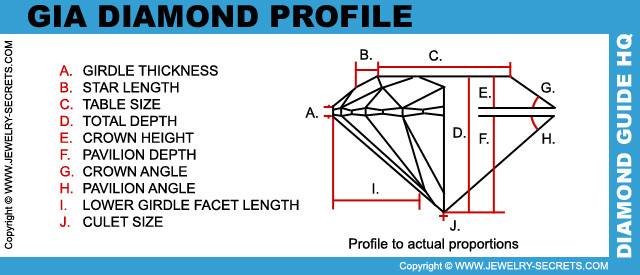
I find myself not paying as much attention to all these facts and figures as I used to. The new GIA cut grades made it easier for me to see how a diamond is cut and also explain this to customers. It makes my job easier. :)
If you want a diamond that sparkles like a million stars in the sky, select a diamond with an excellent or a very good cut grade.
Because we all know, that sparkle and life (cut) is what a diamond is all about.
Moving onto the next section of the diamond report titled “additional grading information“, we come to finish…
14) Diamond finish, polish and symmetry:
Even though the finish (polish and symmetry) is part of the over-all cut grade, GIA lists it separately on the diamond report because it plays such a huge role in the appearance and feel of a diamond.
The polish of a diamond is how smooth and perfectly flat the facets are polished. If a facet has cut marks, or grain lines across the facets, they can alter light and even make your diamond look a little wavy. Light can reflect off these blemishes (external inclusions) and create a distracting or distorted view.
The symmetry refers to how closely the facets are in proportion to other facets of its kind. Star facets should all be perfectly identical… The same height, same width, same angles and proportions.
If you measured and cut these facets apart, laid them one on top of another, they should all match up and look similar (like they were made from a cookie cutter).
The closer the proportions and facets get to ideal, the better the diamond will face up and bring beauty and light to the diamond.
GIA grades polish and symmetry with the same categories as cut: excellent, very good, good, fair and poor.
I always recommend a diamond with excellent or very good polish and symmetry. :)
If you want your diamond to sparkle like no other, select a diamond with triple excellence; excellent cut, excellent polish, and excellent symmetry.
15) GIA diamond fluorescence:
Fluorescence is simple. Either a diamond has fluorescence, or it has none. :)
None is the best (in my book).
Fluorescence is when a diamond has a naturally occurring phenomenon, in that a diamond can glow-in-the-dark under a UV light (think black light).
While some very famous diamonds have fluorescence (like the Hope Diamond), and it may look cool in the dark, fluorescence can be a diamond quality killer.
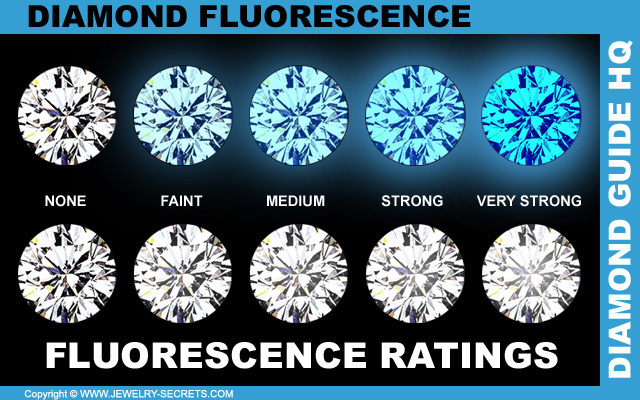
Fluorescence can cause your diamond to have a milky or cloudy appearance. Even if that diamond is a flawless diamond with perfect pure white color and an excellent cut… If it has strong fluorescence, it may make your diamond look like a low-grade, inclusion filled, foggy stone. Not cool!
Not all diamonds with fluorescence will make a diamond look bad. Just know that some will. You really have to look at each and every diamond to tell if it affects the beauty of the stone.
Fluorescence can affect the price of the stone as well. Usually when you find an exceptional diamond deal (cheaper), it’s because the diamond is either cut poor (bad make), or the diamond has fluorescence. That stone may sound like a great deal, but it may not look so hot.
My recommendation is to skip a stone if it has fluorescence. Unless you can actually see the stone and view it under multiple lighting atmospheres.
No fluorescence is the best fluorescence!
16) GIA diamond report comments:
The comments section of the certificate is for any additional points or comments that may help identify or classify the stone being graded. Not all inclusions may be listed on the plot (like there are 40 pinpoints all next to one another, GIA may only show half of them… overkill, you get the point).
Take a look at the additional comments section…
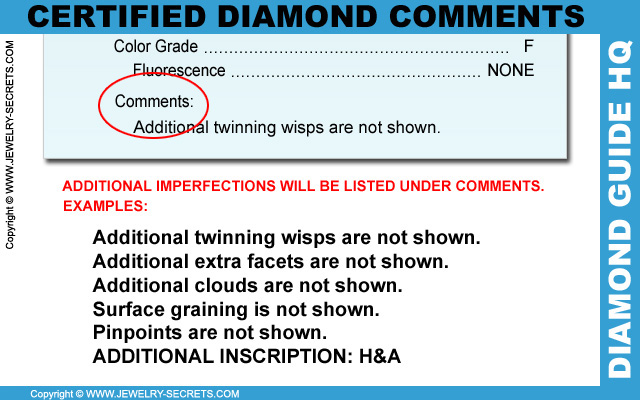
These types of comments are common. Look for cool things like naturals, trigons, and grain lines to show up here. :)
Comments are nothing to worry about. They are just another way to identify your stone.
17) Additional inscription:
If your diamond is laser inscribed (not by GIA), that inscription will show up here (as in this example). If your diamond is a hearts and arrows branded diamond, the report will read: H&A.
Again, these are just another way to characterize and identify your stone.
18) Price:
Surprise! One awesome thing you’ll notice (that other certificates companies do), is the fact that GIA won’t put a price on the report. They put no value on the certificate whatsoever.
This is because GIA isn’t interested in what a diamond is worth or what a jewelry store may sell it for. They are only interested in giving you the most accurate appraisal of your diamond and the diamond’s characteristics.
If you ever see a diamond amount or price on a certificate… Be cautious. Question their reliability and accuracy. Diamond prices fluctuate daily and a price set in stone on the report is not a great representation of the diamond market.
Save the price and replacement value for insurance papers.
19) GIA disclaimers:
This is the blah-blah-blah section of the report. As with any certification company, GIA states that this diamond certificate is not a guarantee, valuation or appraisal.
They do the best that they can (better than anyone else) in grading their stones, but errors do and can happen. People are human.
If you see anything that doesn’t sound right, or look right, you can send your diamond and report back to GIA to have it re-examined and re-tested by experts again.
20) GIA contact information:
GIA’s contact info, address and phone numbers are on every diamond report. If you ever need to contact them, or get a new certificate (say you lost yours), you can have one re-issued to you. Just contact GIA for all the juicy details.
2 More important points:
2 more things I’ll say about GIA’s diamond certificates…
A) Make sure the certificate is laminated with a security hologram. Your report shouldn’t say sample or be a photo copy of one.
B) Make a copy of your diamond report and submit it with your diamond ring appraisal to your insurance company, so your ring and diamond can be replaced much faster and much more accurately if need be. You never know what happens in life.
I hope this post helps you understand GIA’s diamond certificate reports better. Their reports are neat, clean and easy to read… especially now that you know what it all of it means. :)
See more of my favorite GIA certified stones here.
Cheers! :)


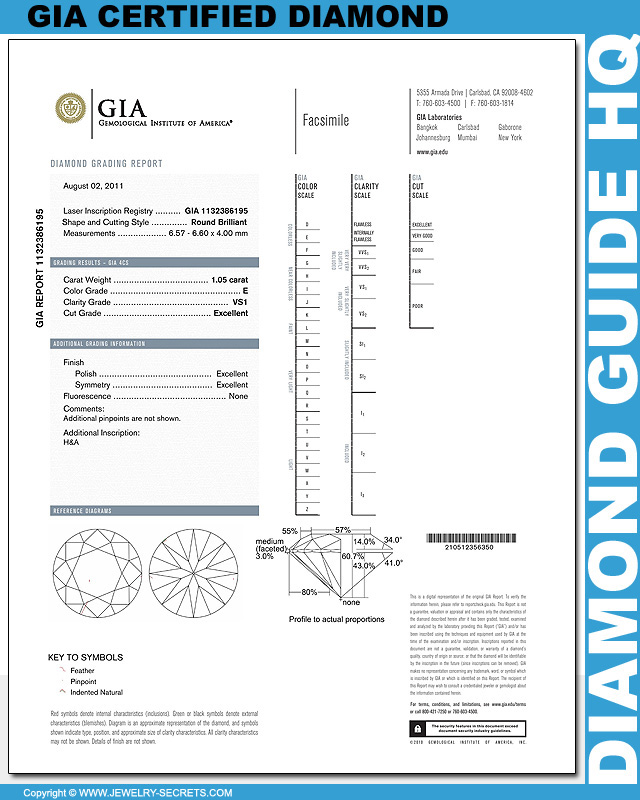
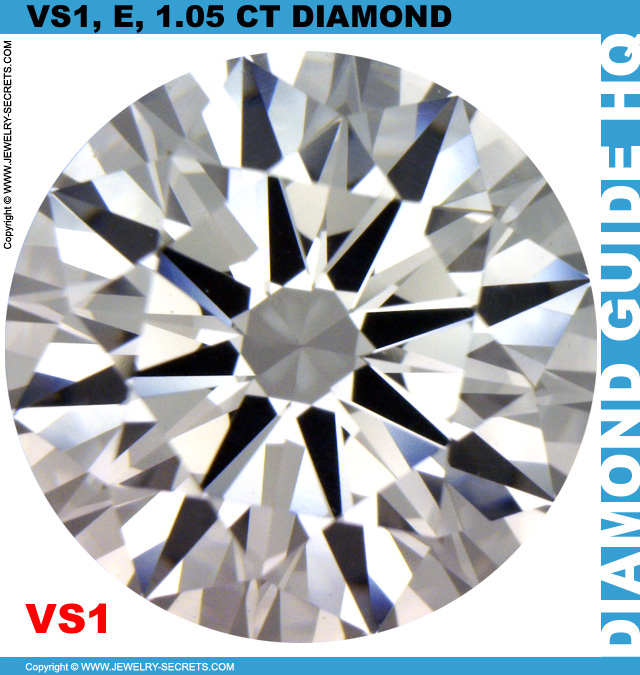
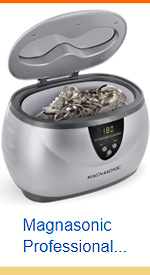

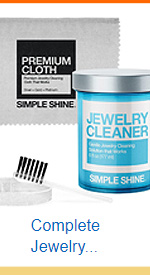
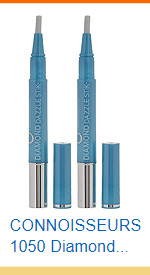
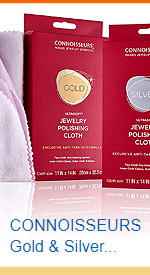
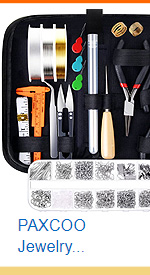
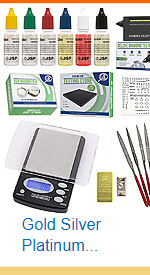
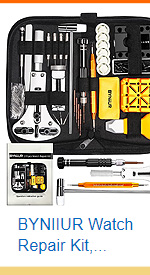
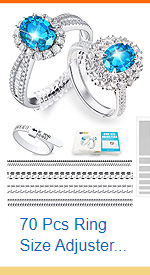
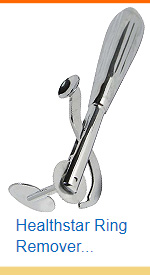
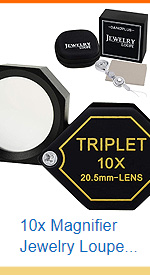
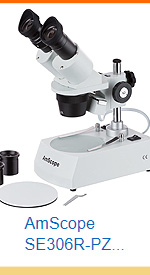




Hi! What does QQ mean (followed by a colon and numbers) in the comments section of a Gia report?
I need about 1.50carat Canadian diamond D or E colour Round
Flawless. Email me
Hi Leeta. Check out 1.50 Round Diamonds here. :) -Richard
What is ideal measurement in mm for 2.0 carat stone? I’m looking to buy 4 ct tw diamond stud earrings thanks!